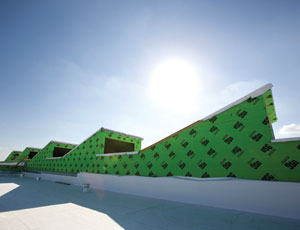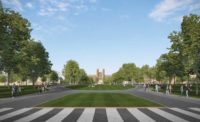Rising fuel costs and limited public school funding have heightened the interest of more than a few Texas school districts in greener, more energy-efficient schools. “They all want to save on energy costs,” says Susan Smith, vice president of Dallas-based design firm Corgan Associates. “It comes out of their operations and maintenance [budgets], so they are poised to save funds.” She adds that more school boards and constituents “want to see recycling and buildings that sustain themselves.”

Corgan Associates designed the $29-million, 152,000-sq-ft Lady Bird Johnson Middle School for the Irving Independent School District near Dallas as a net-zero facility, meaning that over the course of a year it will produce as much electricity as it uses. Set to open in August, the school is aiming for LEED-Gold certification.
Scott Layne, the district’s assistant superintendent for support services, estimates that the school will cost 12% more than an equivalent one built by traditional methods, with most of the additional $4 million linked to the $3-million solar energy system. He expects the district to recoup its investment within 10 to 12 years of opening. “It’s a good use of taxpayers’ money,” Layne says. “The return on investment is good. We are helping the environment and helping the economy.”
Smith says the district expects the school will free up about $250,000 in annual operations costs.
Aaron Scates, vice president of operations for Charter Builders, the Dallas-based unit of Balfour Beatty Construction that is building Lady Bird, anticipates that sustainable, net-zero schools will become the norm. “Buildings like this will play to being more frugal and economically stable,” he says. “On a middle school, electric bills can range from $20,000 to $40,000 a month. A building that doesn’t have an electric bill creates more money for other opportunities.”
During construction, Charter harvested rain and produced power with solar panels on its construction trailer to create a mind-set of sustainability.
The $15-million, 105,000-sq-ft Gloria Marshall Elementary School in Spring, Texas, also provides a host of sustainable features and is registered with the Texas Collaborative for High Performance Schools (CHPS). SHW Group designed the building with a project-based learning environment. Purcell Construction, Humble, Texas, is building the school, which is expected to open in August.
When the district approached SHW about building a greener school, the firm agreed to consider a variety of options. “We looked at everything—from the architecture to the equipment to the orientation to try to cut the energy [use] as much as we could,” says Mark Lam, the company’s K-12 practice director. Lam anticipates the school will use at least 25% less energy.
A typical school rings up $200,000 annually in energy costs. “In addition to saving that energy money, it’s creating a learning environment for students,” adds Tracy Eich, principal designer for SHW’s Houston office. “It isn’t like we have compromised the school; we’ve used it as a way to improve the quality.”
Dave Patton, director of design and special projects for the Dallas Independent School District, says the district buys $40 million worth of electrical power each year. That, in part, contributed to the school board’s desire to build more efficient schools, meeting the collaborative’s code of standards. An example is the $29.4-million, 184,728-sq-ft Ann Richards Middle School, designed by PBK of Dallas, and being built by the Dallas office of Satterfield & Pontikes Construction. It is scheduled for completion in 2012.
Power generation and conservation
A 10-kW solar array sits atop the roof at Gloria Marshall. A 3.7-kW wind turbine also will contribute to reducing the district’s electrical consumption. Lady Bird will be the state’s first net-zero school. At certain times of the year it will need to purchase some electricity from the grid, but at other times the school will produce more power than it will need and can sell that back to the grid, Layne says.
Purchases will cost more than what the district will receive for selling excess capacity. About 64,000 sq ft of Solyndra solar panels will generate 575 kW annually, the bulk of the electricity produced. The cylinders collect energy from direct sun rays and from those bounced off the white reflective roof.
“It’s an innovative way of capturing more sunlight,” Scates says. “It captures for 12 to 14 hours. You will get sun up to sundown and double the amount of light-producing hours.”
The balance of the power will come from 12 Skystream wind turbines, each 45 ft tall, that will generate about 28 kW annually, about 1% of the building’s power needs. “We felt the wind turbines were important to signify that we are using green technologies,” Layne says. He adds that a desire to reduce greenhouse gas emissions and the country’s dependence on foreign oil, as well as the energy-consumption impact on the district’s budget all contributed to the decision to build a net-zero school.
“Instead of budgeting $250,000 to handle utilities for this building, we feel we will only have to budget 20 to 30% of that,” Layne says. “Then we can use that money for instructional purposes for the kids.”
Succeeding as a net-zero facility requires energy conservation, Scates says.
“The more efficient you can make the building to begin with, the less energy it needs to operate,” Layne adds. “The less energy it needs, the less renewable systems you need to put on the building.”
Lady Bird uses a geothermal system with 530 250-ft-deep wells and 105 water-source heat pumps. Layne expects this to decrease energy use by 30% to 40%. “With a geothermal system, the savings are almost immediate,” Smith says. She adds the design reduces energy load with a more efficient building envelope.
The Irving district increased the insulation value in the walls and roof at Lady Bird to an R-30, rather than to an R-18 or R-20. All of the glazing uses high-efficiency glass, allowing light into each classroom without heat gain. Daylight sensors will dim or increase the light fixtures depending on natural light.
Students at Lady Bird will receive wireless laptop computers to reduce the plug load by half compared with a school computer lab or library with banks of desktop computers. Students can recharge laptops in a science lab or in storage and maintenance areas.
A geothermal system also will heat and cool the Ann Richards school. Patton expects the system’s 757 300-ft-deep wells will save 35% on utility bills compared with a similar school. It also will have a reflective roof to decrease the heat-island effect, high-efficiency glazing, no windows on the west side and a crawl space.
“There’s a ventilated crawl space, so it doesn’t bake down there,” says Nic Flannery, school project manager with Satterfield & Pontikes. “It draws in outside air and exhausts out crawl space air”
Article toolbar

Post a comment to this article
Report Abusive Comment